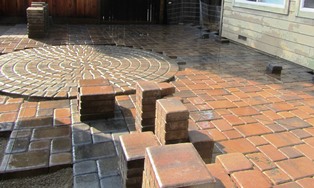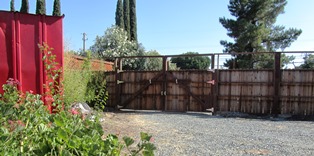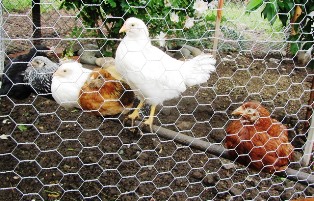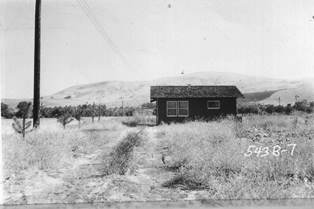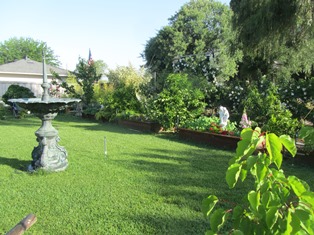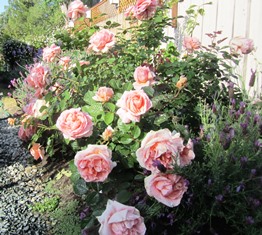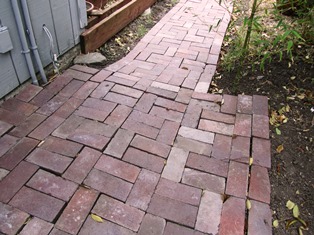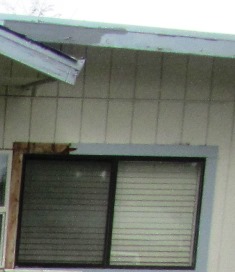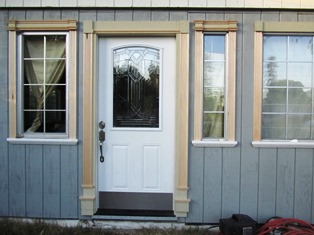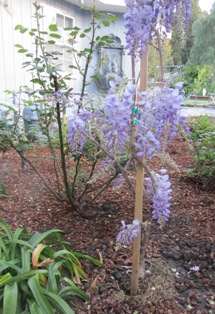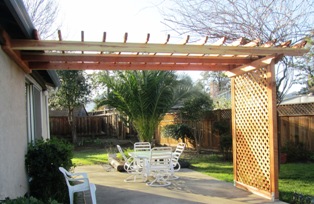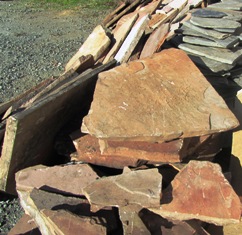Archive for the 'Renovation and Construction' Category
Carlos Lays a Beautiful Stone Floor Despite Some Surprises
My daughter knew my husband Carlos had an opening in his schedule and wanted him to create a carefree stone floor for her backyard. She wasn’t interested in grass or plants, given the California drought, and her husband came up with a design. Easy.
But as it turns out, the design was fairly complicated. It consisted of a cross with a circular medallion. The stones were four different sizes and two different colors. Maybe not so easy.
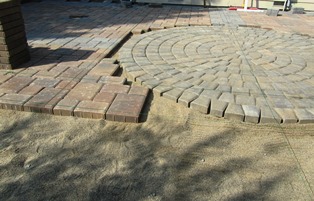
Green string, tightly strung provides a guide for correctly positioning the stones in the circle and in straight lines
Carlos, nevertheless, rose to the occasion and with a buddy got to work. My daughter swore that all the sand and rock Carlos would need were already there from the previous patio, but that turned out not to be the case.
So imagine Carlos’s surprise when he realized he would have to pull out the dirt, level the ground, and do all that prep work before he could start laying stone.
Everyone put their stress aside, ordered sand and gravel, assemble the tools like the rake, mallet, and wheelbarrow, and enlisted one of our neighbors for additional help.
It took more than week. But the work is almost finished. My daughter loves the patio and she’s already planning a late summer party to show it off.
Carlos is thinking maybe we could use a floor like that on our farmette. With all the work we do, it’s nice to have a flat floor with a bench and table to sit a spell and catch your breath.
Building an Expensive Estate Fence for Next to Nothing
Over the last week, my husband build an eight-foot-tall estate fence across the front of our property. When I wasn’t writing or doing other chores, I helped. We’re big believers in recycling, so naturally, when it came to the fence, we found a way to build it without cutting down a single new tree and use lumber that might otherwise go into landfill.
The idea for the fence is to have something beautiful and functional. We now have a fence next to the street and an interior fence. Between the two fences is a spacious half circular driveway where our cars and trucks can enter, leave, or park.
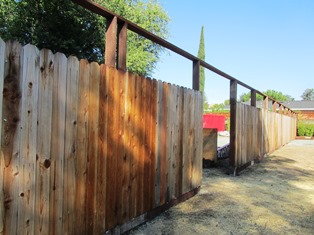
The new fence is 110 feet long with two gates, one opens for cars and the opens to the curved stone walkway
We were given some 6-by 6 posts (about 70 of them) by a friend working in demolition. A lot of useable pressure treated lumber came in the same delivery. We had saved fence boards we bought four years ago and, in an unbelievable stroke of luck, we had enough to cover the entire fence except for the very last 16-board section.
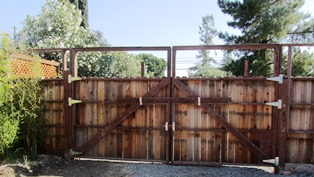
The wooden gate swings wide open to permit a vehicle or heavy machinery access (I’m thinking a boat would be nice)
Our plan is to add trellises on top of each fence section and install large wrought iron gates that will open electronically. For now, we just have an opening at one end of the fence for our curved stone path leading to the front door. The wooden gate at the far end of the fence will permit a truck or car to enter the back of the property.
By stacking the 6-by-6 boards on top of each other and drilling them together in place, Carlos made what amounts to planter boxes for the bamboo that line the property.
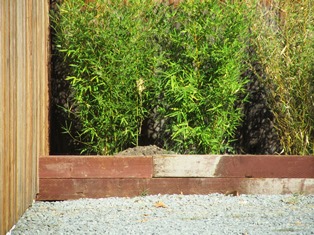
Stacked 6-by-6-foot lumber holds bamboo. Although one board needs staining, we don’t complain because the lumber was free
Gunshot Triggers Howls and Cackles in the Hood
Farm life isn’t always quiet. Night before last, a shot rang out around 11:00 p.m. It happened after some people in the neighborhood had engaged in a running argument, lasting hours.
My husband and I heard the arguing during our romantic dinner on the patio. His birthday is tomorrow and we celebrate birthdays all week, you see.
Hubby said he knew the sound of gunshots when he heard them. He was even more certain he’d heard the words, “We got to get out of here!” I was tempted to dive under the bed because people on the run with guns . . . well, that could be dangerous.
In the dark, you don’t know what has happened. I write mysteries. I’m thinking, “is there a body on the adjacent property?”
Three uniformed police officers arrive with nightsticks in their duty belts and guns in their holsters. With their flashlights drawn and turned on, they searched for a way into fortress that the neighbor has built or a means to see behind the tarps the neighbor has strung to hide his backyard and sheds.
Over the barking of the neighbor’s pit bull, I heard one officer tell the others, “This is like the Beverly Hillbillies. We’re notifying Code Enforcement.”
Glad it wasn’t our place they were talking about. We’ve been renovating . . . but neatly. Still, there’s the unfinished porch, the pile of lumber . . . .
I watched the erratic beams of their flashlights as they searched. Then . . . here they come, lights bobbing, down our driveway. They want to see if they can penetrate the fortress of the Beverly Hillbillies from another direction. Our house is in close proximity.
My husband went searching for a ladder. Call me silly, but I thought it would be the tall, thin officer, who would climb up. No, that would be too logical. It was the short, chunky one scaling into the heights, disappearing into the elm tree. Did I mention the tree has an almost impenetrable canopy in summer? Not surprising that he couldn’t see anything.
The officers decided on a look-see from the rear. My hubby guided them through a field, past the apiary and chicken house.
Roosting chickens are usually quiet. No doubt, you’ve heard the expression, “Going to bed with the chickens, rising with the rooster.” To say my hens were alarmed might be an understatement. They’d been roused from their slumber and cackled like there was no tomorrow. I realize there’s a bit of irony in the fact that our place is called the Henny Penny Farmette after Chicken Little’s story about the acorn falling on her head. This could have been the sky falling. They cackled like it was.
The deafening cackles agitated the neighbor’s pit bull, whose incessant barking got all the dogs in the hood howling. A fire engine shot by, sirens blaring. I took an aspirin, waited for my husband to return and the officers to leave.
Back in bed, who could sleep? I worried about when about when Code Enforcement might show up to cite the Beverly Hillbillies. Would the officers look over the fence and cite us as well? Code Enforcement aside, a gun-toter could hide behind our pile of porch lumber. We gotta get that porch finished.
But, like I said, it’s my husband’s birthday. He’s feeling romantic this week and not easily pushed. See my conundrum?
The Farmette Renovation Work Continues through All Seasons
I met with the tax assessor last month and he gave me a picture of our small farmette house from 1953. At that time, the house was only six months old. Over the ensuing years, many changes were made, rendering the tiny miner’s shack or bunkhouse (that appears to have been a single room) into a 2-bedroom, 2 bath house of roughly 1,000 square feet. We continue to renovate but limited resources slows everything. Eventually, we’ll have a small finished house in a lovely environment.
When we found the property in 2009, it was in foreclosure and looked like a dump. That’s because it had been used as one. Broken pieces of granite and cabinetry wood had been piled along its aging, rotting fences, too weak and weary to remain upright. Inside, the hardwood floors had been ripped off and everything that could be “harvested” from the house by others had been taken. The only appliance was an old refrigerator sitting a weed-field that served as the back yard.
But we saw land all around. Rising up to the north in back of our farmette are hills (emerald green in the rainy season) that separate the inland valley where our farmette is located from the great Central Valley of California. Seeming as near as our front yard, the blue-green peaks of Mount Diablo tower over the landscape in the east and southeast (we now see these from our living room couch and front porch). From the northwest in summer, the breezes off the San Francisco Bay where it becomes the Straits of Carquinez blow toward Mount Diablo around 4:00 P.M. every day to cool the area.
After pulling out the weeds that at one point towered over our heads, we envisioned re-engineering everything. We constructed a new landscape that included fruit, citrus, and nut trees, beds for roses and other flowers, an heirloom herb and vegetable garden, and a designated area for bees and chickens.
Without a huge budget, we believed the renovation of the house would be ongoing (and it has been). This is our fourth winter. When we are not working outside, we are working on the renovation inside. For example, recently we installed window trim in the living room. Today, I’ll caulk, spackle, and sand in preparation for painting later this week.
Previously the entry into the house was through a side door and bathroom. The first impression wasn’t good. My husband created a welcoming entrance with exterior moldings around the windows and door. I talked him into a screen door and a porch (as yet unfinished) with a trellis to support purple wisteria.
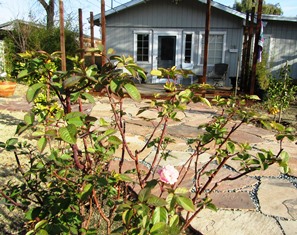
A flagstone path lined with roses and citrus trees leads to the new front door but the porch is yet to be finished
Since unseasonably warm temperatures have been forecast for the week, we have begun work on a flagstone walkway leading to the porch. I love when Carlos gets out string, stakes, and the can of marking spray and begins putting down boundaries for fences, walkways, stone paths, and garden gates. The tax assessor didn’t ask about those markings. But we expect the property value to be listed higher next year because of the renovation we’ve already done.
Less Mopping, More Writing
It may not be immediately apparent what recycled bricks have to do with writing, but bear with me. A friend who does professional demolition of houses and properties brought us a truckload of bricks from an owner who was re-landscaping his upscale property in a nearby East Bay city. Otherwise, those bricks were destined to be discarded in a landfill.
Temperatures hovered near 70 degrees Fahrenheit this past weekend (Thanksgiving) and the weather was perfect for us to lay a brick walkway. My architect husband and I are passionate about recycling materials that still have life in them. It’s one of the reasons why two of our favorite places to visit are architectural salvage yards in Berkeley: Ohmega and Urban Ore. See http://www.ohmegasalvage.com/ and also see http://UrbanOre.com/
With the rainy season on its way, it seemed like a good idea to lay the brick in a pattern along the northwestern side of the house where we keep the recycle and garbage bins. During winter, we track a lot of mud into our small farmette home because we have only dirt and gravel paths through the garden and orchard areas.
This year, it will be different. The newly laid brick walkway runs from the front to the rear of the house, joining the front porch (that we are currently building) with a gravel path leading to the property line. We laid out the brick pattern and tapped them close together, using a rubber mallet (since hitting brick on brick can cause breakage).
We still need to pour sand on top and sweep it into the cracks. But this kind of path can last for years. The ancient Romans built similar paths that remain to this day. The rains will come, but less mud will be tracked in because of the paving stones. That means for me fewer hours this winter spent mopping the mud tracked in and more time writing on my cozy mystery series.
Windows on the World
We’ve been updating our windows on the farmette house. The work recently triggered a memory of an incident involving windows at the start of the remodeling of my San Jose home years ago.
Back then, even before the architect had begun the drawings, I informed him I wanted lots of windows and even noted placement, size, and shape. The poor man hadn’t even drawn the walls yet! We had a good laugh over my exuberance.
Here on the farmette where I’m married to the architect, I recalled that memory while we were pulling out the single-paned windows and replacing them with more energy efficient, double-paned windows.
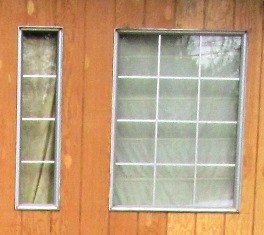
New windows can significantly transform the exterior appearance of the house as these as-yet-unframed ones demonstrate
The new windows will lower our energy bills and provide us with views of the world beyond the walls. From inside the house, I can look out and see my fairy garden (the Iceberg hybrid tea rose encircled in a mass planting of gray-green yarrow) and the blooms of purple and white irises in a circular planting around the almond tree. Once we’ve added trim and paint, the view outside in will be no less spectacular.
Spiffing up the Farmette for Easter
Finding inspiration in books I wrote long ago, I ‘ve been sprucing up the house and grounds in time for Easter weekend. Family and friends will be visiting. Rain has helped our roses to start blooming and the wisteria is manifesting gorgeous purple bracts in a new garden area where we’ve planted a dozen new rose bushes.
The richly woven linen-and-silk tablecloth I purchased at a sidewalk market in Greece (during the writing of my Everything Women of the Bible book) provides a formal look to the dining table. I added matching napkins and some vanilla- and mocha-colored candles in tall stemmed crystal holders to create a formal look.
In the living room against a raspberry colored wall, I positioned on the piano a pair of French style lamps with tall top hat shades. The ambiance of the informal but warm living room seems to invite conversation.

The Nyjer seed feeder beyond the kitchen window attracts finches while daffodils on the window sill cheer the cook
I love the greenhouse window in the kitchen but hanging a bird feeder outside reminds me (and my visitors) that here on the farmette, nature is never far away. Looking through the window from the kitchen got me thinking about flowers and floral patterns.
Years ago, I wrote a book titled, Blooming Rooms, with my friend and fellow writer A. Bronwyn Llewellyn. We divided up the writing of the chapters based on rooms of a house. She wrote the chapter on kitchens and one of her brilliant ideas was to decoupage a serving tray with antique flower seed packets. Thinking about that book inspired me to bring some flowers into my kitchen. I searched for a pretty vase, filled it with water, and plunge into it a fistful of daffodils.
Finally, I believe our little home sweet home is ready to receive company.
Building A Fence Brings Neighbors Together
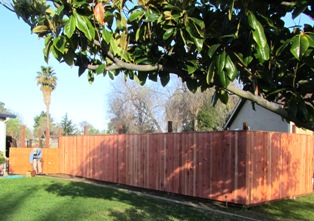
Carlos Carvajal, my architect-designer husband, near the fence we have been building for our neighbors
My husband is good at what he does. His highly developed aesthetic sense for design and sense of proportion and drive for perfection has proven invaluable in the projects he designs and builds. For the last two weeks, he’s been working one farmette over, replacing an old fence and crafting a trellis to support a gorgeous Japanese wisteria about to bloom.
I’ve been helping on the days he doesn’t have extra workers. Although I’ve helped him build fences on our property, the fence for our neighbors was a bit different. It would include supports for a lattice and would extend about 100 feet in length between the two properties.
Our neighbors are lovely and the building brought everyone together. We shared bottles of water and cups of juice, noonday meals, and lots of conversation. We worked through the weekend and since yesterday was Sunday, we even met extended family members who came to visit and to observe the fence building that was going on.
We shared a lovely Saturday lunch, thanks to the neighbors on one side of the fence and a beautiful Sunday lunch, gratis the neighbors on the other side of the fence. When the sun grew low on Sunday afternoon, yet another neighbor invited us over for a sumptuous meal of salad and grilled salmon. While the salmon cooked, we plucked two huge bunches of leaf lettuce from my garden and rolled lettuce leaves around slices of sheep’s milk cheese and sardines. The food went down perfectly with a central coast zinfandel from the Sterling vineyards.
I almost hate to have the fence building end. It’s been a wonderful experience to learn about the families living nearby and to share our love of our construction and gardening with them. In fact, it’s been the discussions about gardening that have proved for me most gratifying. I’ve enjoyed seeing their fruit trees in bloom and learning gardening tips they have shared.
Some people might believe that putting up fences hinders the fostering of neighborly relationships, but I’d have to say that it was the fence construction that helped us get to know our neighbors better.
Moving Dirt
Moving wet and damp dirt is not easy. Worse, it’s dirty work. However, we are working a master plan for the landscape that includes a sitting area, a back yard in two levels, and an area that includes fruit trees, raised planting boxes for flowers, and a large vegetable garden.
The window of opportunity has opened for improving the soil before planting our summer garden. The soil is not too wet, nor too dry. Right now, this clay soil can be worked by hand and by machine.
My neighbor has already turned the earth in his garden several times. A couple of days ago, he pushed his rototiller through the gate dividing our respective properties and offered to till the soil in the area where I’m going to plant my summer garden.
The turning of the soil exposed not only a huge amount of rocks but also gravel. The previous owner of my property had at one time used the area for a gravel driveway. That meant compacted soil and lots of stone and broken pieces of granite and marble (the former owner was a building contractor), which I set about removing by the bucket. I recycled that rock onto a pathway in the garden.
Come summer, I know I’ll be glad I did all that dirty work, reintegrated the rock and gravel, and amended the soil. Good soil will grow just about anything you put into it. And I’ve already started dozens of open-pollinated vegetables in seed flats in my kitchen.
Recycling Landscape Materials
My ears perk up when I hear someone talking about renovating his or her landscape since such a project often involves removing not only plants but potentially brick, flagstone, and other types of outdoor flooring and landscaping materials.
After learning about a demolition going on down the road recently, we inquired whether or not we could haul away the unwanted stone. The property’s owners had already begun the tear-out as a first step in revamping the home’s entire landscape. Out came decades-old rose bushes and two types of stone, some of it slate.
Flagstone, redstone pavers, and boulders can be reused to create raised beds for flowers, herbs, or vegetables. A caveat about using natural stone or boulders: keep them low as soil can sift out between the cracks unless you use mortar. Better still, use landscape fabric as a barrier against the soil sifting.
In our arrangement, the homeowner will not need to pay someone to haul away unwanted materials. We will not have to pay for the stone. We can stack it on our property and when we are ready, use it to construct an outdoor kitchen floor or sitting area. Most importantly, we are recycling, keeping the unwanted landscape materials out of landfill.
 Facebook
Facebook Goodreads
Goodreads LinkedIn
LinkedIn Meera Lester
Meera Lester Twitter
Twitter





